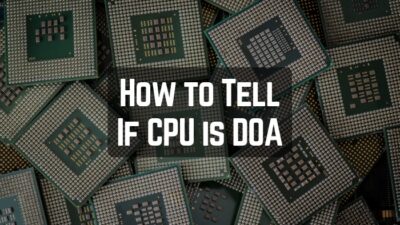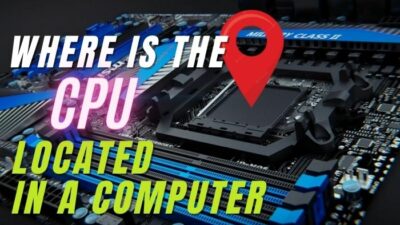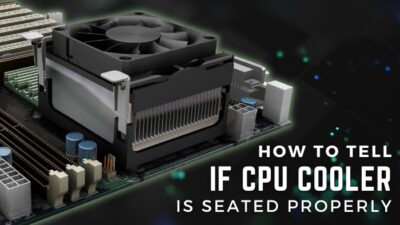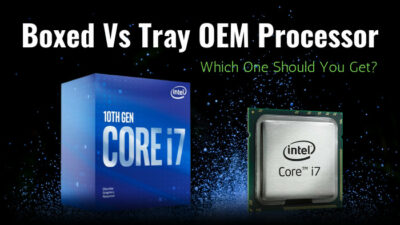Whether you use a desktop computer, laptop, or mobile, a CPU is the single common thing you will find in your device.
If you are a newcomer in the tech world, the first and foremost thing you must know is the full form of the CPU, its definition & function.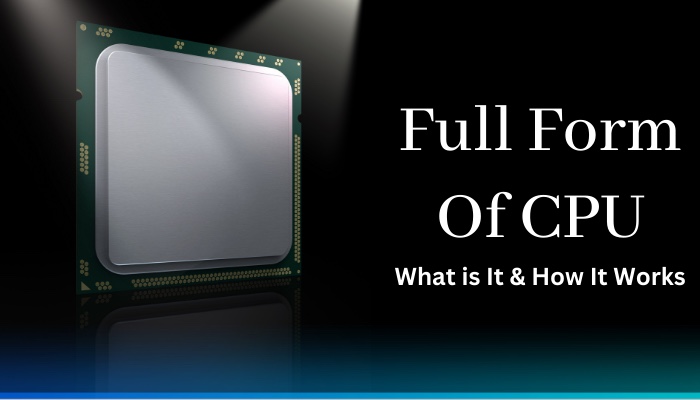
Here I will explain that. In addition, I will describe how the processor operates and some exciting backstories of the CPU.
So, tag along.
What is the CPU’s Full Form, Definition, and Function of CPU?
CPU stands for Central Processing Unit. It is the main component of the PC that controls and executes all the instructions of a computer system. When you instruct your PC to perform a task, the CPU performs all the basic arithmetic and logical operations to get the job done.
If you compare your computer to a human body, the CPU will be the brain. A specific space in the motherboard called a socket is where you must install the CPU when you build a new PC. It won’t fit elsewhere.
You can use the term Processor instead of CPU all the time, as both are the same.
The primary function of the CPU is to fetch the instructions that the computer programs, decode them, execute the task, and return the task’s result.
Another awesome thing about modern CPUs is they can complete billions of instructions per second. To know more about the central processing unit, go and read our other article, which is about whether a CPU is an input or output device.
History of CPU
The first binary-coded decimal (BCD) based commercial CPU, Intel 4004, was invented by Italian physicist Federico Faggin in 1971. Intel released that processor in March 1971. The following year, in April 1972, Intel released an 8-bit architecture, the 8008 CPU.
However, that’s not the beginning of the story. There is a backstory and after story related to that incident. In the table below, I have briefly explained all of that.
Here is the history of the CPU:
| Year | Historical Events of the CPU |
|---|---|
| 1823 | The fundamental component, Silicon, was discovered. It was Baron Jons Jackob who found that element. |
| 1903 | Nikola Tesla patented the electrical logic circuits (gates or switches). |
| 1947 | John Barden, Walter Brattain, and William Shockley invented the first transistor at their Bell Laboratories |
| 1958 | First integrated circuit was developed by Robert Noyce and Jack Kilby |
| March 1971 | Intel 4004 was invented by Italian physicist Federico and Released. |
| April 1972 | Intel 8008 came out, which was an 8-bit microprocessor. |
| 1974 | Intel 4040 came out, which was an updated version of 4004. |
| March 1991 | The AM386 microprocessor family was introduced by AMD. |
| March 22nd, 1993 | The Pentium processor with 60 MHz clock speed was released by Intel. It was built with 3.1 million transistors. |
| January 4th, 2000 | Intel released their new Celeron CPU which had 553 MHz bus processor in its system. |
| April 22nd, 2006 | The Core 2 Duo processor E6320 was released. It was developed by Intel. |
| November 2008 | The first Core i7 Desktop processors came out. |
| January 2010 | Intel released the Core i5-430M and Core i5-520E. These were the first mobile processor that ever came out in the market. |
The story doesn’t end here. There is more. But these were key backgrounds that lead to modern faster and more powerful CPUs.
Today’s processors run at GHz clock speed, whereas the old ones ran at MHz clock speed. So, you can see how far we have come. We will move forward as time passes.
Different Types of CPU
It’s important to know different types of processors. In the past, there were Transistor CPUs, Small-Scale Integration CPUs, and Large-Scale Integration CPUs. The revolution in the CPU happened when microprocessor types of CPUs came onto the market. Now you will see single-core, dual-core, quad-core, and many more core types of processors.
Small-scale integrated (SSI) type CPUs were the first integrated circuits that contained a handful number (probably ten) of transistors in their system. Though the numbers were a little, they were very significant for the advancement of today’s computer.
When the Large-scale integration (LSI) type CPU came on the market, it had thousands of transistors in one silicon semiconductor microchip. These types were popular in the 1960s and 1970s.
But when the microprocessor-type CPU arrived in 1971, it changed all the CPU implementation methods. For a long time, the CPU used to have a single core. But as technology advanced through the years, CPU core count has increased incredibly.
Currently, we have core-based processors such as single-core, dual-core, quad-core, hexa-core, octa-core, and so on.
Single-core CPUs have one microprocessor, dual-core has two, quad-core has four, and it continues.
A single microprocessor can perform one task at a time. The more core a CPU has, the faster your PC will work and the more instructions it can handle simultaneously.
Different Components of CPU
Structure-wise, the CPU can be different. But all processors have three main parts in their system. These are Arithmetic Logic Unit (ALU), Control Unit (CU), Registers, or Memory. When you give a command to your PC, these CPU components come forward to complete the task.
Let’s see the brief details of the components and what they do in the CPU.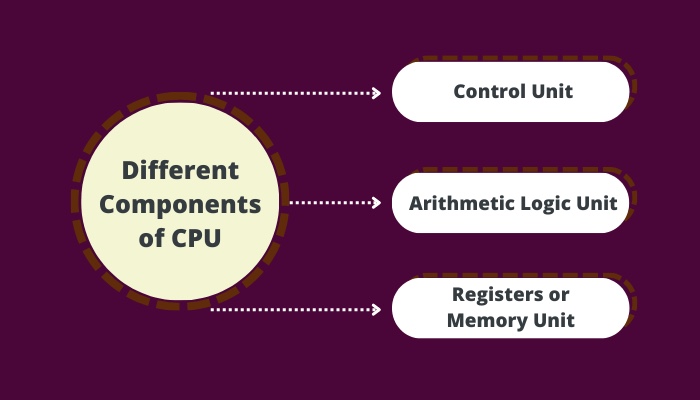
Here are the three main components of the CPU:
Control Unit (CU)
If you ask which is the main component of the CPU, I will always say it’s the control unit. Because it handles all the operations and tasks of the computer. It manages the PC’s memory, input or output devices, and executes sequences, etc.
Since the CU is the center point of all processing operations, you can say it’s the backbone of the CPU.
An important thing you must know about the control unit. It does not handle or store any data in its section. Rather, It takes instructions or data from the memory unit. After that, it interprets that data and uses the results to determine how the computer should function.
Arithmetic Logic Unit (ALU)
Another crucial part of the CPU is the arithmetic logic unit. Shortly, you can refer to it as ALU. The ALU carries out any mathematical, logical, comparison-based, and decision-making process that requires running the PC.
It handles mathematical operations like addition, subtraction, division, and multiplication. And for the logic it controls all AND, OR, less than, greater than, equal to, etc. based operations.
In summary, ALU performs all these procedures to complete any complex operations.
Registers or Memory Unit
There is a built-in memory mechanism in the processor, which refer to the memory unit of the CPU.
This memory doesn’t dwell with your main memory device (RAM). Instead, it’s one kind of the smallest and quickest type of computer memory that stays inside the CPU as a register and cache. So there is in fact a physical register on the CPU.
The CPU can use this memory for its benefit to run any input data, commands, and results.
Nonetheless, the CPU memory is limited. That’s why it stores only the most relevant data in its system and other additional important data in the main memory based on the data’s size.
If you look at some old and new CPUs and compare their size, you will see that modern CPUs are smaller than their predecessors.
How the CPU Operates
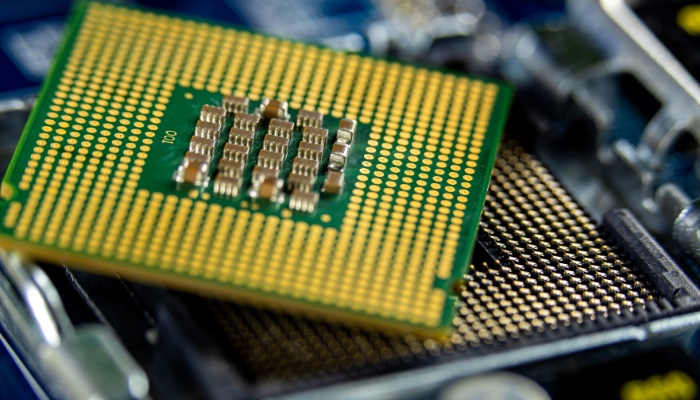 The CPU performs its operation in a fetch-decode-execute cycle. First, it picks up the instructions from memory, decodes that command, and executes the necessary calculations to complete the task. This whole cycle is done by the Control Unit, ALU, and Registers.
The CPU performs its operation in a fetch-decode-execute cycle. First, it picks up the instructions from memory, decodes that command, and executes the necessary calculations to complete the task. This whole cycle is done by the Control Unit, ALU, and Registers.
When you give an instruction to your PC, like opening a folder, it goes to the RAM first. The control unit of the CPU fetches that instruction from memory. Then it decodes them in a way that only the CPU will understand.
After that, the decoded information is sent to the ALU (Arithmetic Logic Unit). It efficiently performs all the required calculations.
Temporarily, the CPU stores the memory of the data in its registers’ or memory unit, which is currently being worked on. When it’s done, CU sends back the result to the memory.
And you get to see the folder which you give instructions to your computer to open. That’s how it operates.
Are you going to install a new processor on your PC? Then you should read whether you need to reinstall Windows when you set up a new CPU.
FAQs
What is another name for a CPU?
Another name for the CPU is the processor. You can also state the CPU as a main processor or central processor.
Do you need a CPU in a computer?
Yes, you must need a CPU in a computer. Without it, it’s impossible to build or use a computer.
Is the CPU a system unit?
Yes, the CPU is a system unit. Since the system unit refers to the part of the computer that performs complex calculations and provides results, which more or less the CPU does.
Final Thought
CPU is the basic structure of the computer world. You must know all about processors before you go ahead and pursue your career in this area.
I hope now you know the full form of CPU and all the basic knowledge of it. Comment below if you have any additional queries.
Peace!

